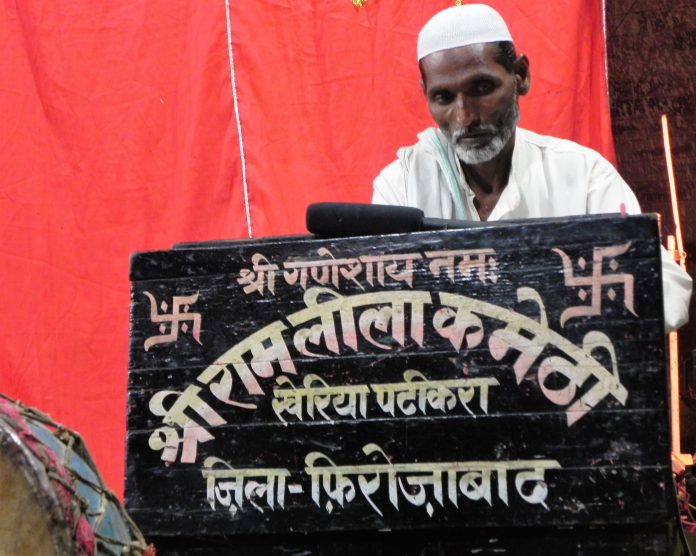New Delhi, (IANS): Nestled in Uttar Pradeshs glass-factory district of Firozabad is Kheriya, a small village which for over 50 years now has been enacting the hugely popular Ramlila with pomp and fervour. What makes it distinct is that Muslims form the majority of its cast, presenting an enduring and spectacular tapestry of communal harmony.
The Kheriya Ramlila, a fine example of the composite nature of the camaraderie between Hindus and Muslims, has been captured in a captivating manner in a 66-minute documentary produced by Indira Gandhi National Centre for the Arts (IGNCA).
Documented by Prof. Molly Kaushal, of Performance Studies, IGNCA, the film, “Leela In Kheriya,” offers a beautiful commentary on the concept of life and existence, with images of glass factories and smelting glass in its furnaces, borrowing them as metaphors for the concepts of creation and the relentlessly moving ‘Wheel of Time’.
“The village of Kheriya has an almost equal percentage of Hindus and Muslims, and the tradition of enacting the Ramlila began, like most places in the country, in the 1970s. The village is very surrealistic as the people are comfortable with their identities, thus making it easy for them to speak the dialogues, laced with humour and satire, in an effortless manner,” said Prof Kaushal.
The director moves into the lanes and bylanes of Kheriya where the individual selves of the inhabitants and their daily grind are enmeshed in many ways with the quest for the sublime.
Through interviews and monologues, the film reveals the personal history of the inhabitants of the village, whose lives are filled with sorrow and dejection on one hand and hope, courage and indomitable sport on the other.
“Each of their individual journeys converges on the Ramlila stage. The Ramlila is a redeeming point for each of them, the stage brings them together on a singular platform and they undergo a very strong sense of self-recovery,” the director noted.
“There is this amazing cross-dresser who plays the part of Sulochana, who has a very strong tradition in folk theatre unlike the Valmiki and other texts of the Ramayana and you should see the dialogues he comes up with,” added Prof. Kaushal, who specialises in oral traditions and oral performative style.
Based on the text of Katha-vachak Radheshyam, one aspect of the film explores the passion of the amateur artists. The character, who enacts demon-king Ravan, says when he goes on the stage, he forgets everything except that he is the great Ravan. So also are the characters of Rama and Lakshmana as indeed everybody else.
“I begin the film with a shot of the glass factories as a metaphor of cosmic creation. There are images of wheels of all types, grinding machines churning and spinning to showcase the cycle of time as well as the churning of cosmic time-eternal, ceaseless, relentless and sublime,” the director recalled.
In the climax of the Kheriya Ramlila where Ahi Ravan is killed, the director introduces a self- choreographed sequence outside the stage. The documentary ends where it began, in the glass factories, where molten glass for Shivalinga symbolises the eternal flow of Leela both in this world and in the cosmic realm.
“I looked at Kheriya’s giant furnaces and realised that this is probably how hell looks like. I looked at the lithe bodies of the people manning the furnaces and thought perhaps this is how God’s universe looks like. On the surface, the lives and journeys of people in Kheriya are so different from mine but the internal journeys are the same. As they find their answer in Ramlila, I too have found self-realisation in the making of this film,” she said, summing up the essence of Kheriya’s Ramlila, which stands apart in its genre.
A mix of poetry, composed by Prof. Kaushal who is also the narrator in the film, Bollywood lyrics and spontaneous witty dialogues leaves the audience in splits.


